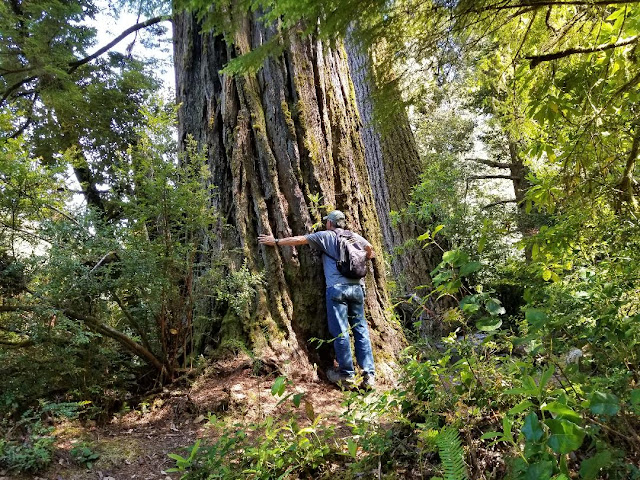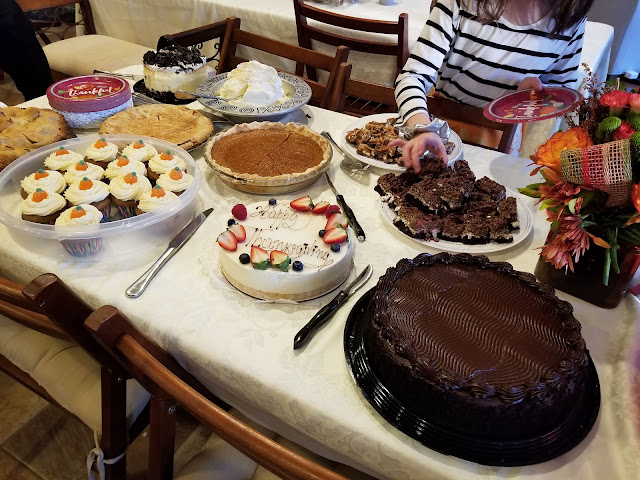"I think that I shall never see
a poem as lovely as a tree."
Joyce Wilmer
 |
| Trying to hug a tree |

I love trees. There's something about them that makes me feel grounded, content, secure. I grew up on a 365 acre farm in mid-Ohio that Dad bought from his father in about 1954 for $25,000. About 75 acres of that were "woods" and a creek that had a swimming pool where it made a turn in the woods. Whether we were catching tadpoles, rock skipping, swinging on a grapevine, or wading on hot days, we were in trees. There were 3 maple trees in the front yard that the electric company trimmed to keep their lines clear and up in the middle of one of them was a flat place where they had lopped off a large branch where I set my tea set and talked to my imaginary guests.
 |
| A place that feels like home |
For several weeks we have walked among massive and beautiful trees. Miles of the coast of California is unspoiled forest and roads that go through what we call "tree tunnels". We have learned that there are 3 kinds of redwoods and the sequoias - which are mainly in the southern part of California - are just one of them. The Coastal Redwoods are mainly in the northern half of California. The third type is only in China.
Sequoias are known for their girth and redwoods are known for their height. Their bark and leaves (needles) are different. Sequoias have small cones and redwoods have bigger ones. Sequoias have wood that is not good for anything but redwoods have really good and durable lumber. Sequoias are frequently standing alone and redwoods are grouped close together in "families".
We have become very aware of the dwindling number of redwoods. We learned that 95% of the old-growth forests in California have been cut for lumber. Some trees are as old as 1500 years. There are some protected trees in National parks but there is still logging going on that cuts really old trees, trees that have withstood fire, snow, wind and lightning for many hundreds of years. There are still protesters that are trying to stop the lumber companies who get a lot of money from the large trees.
The protesters were more active in the early 90's- chaining themselves to trees, standing in front of trucks and bulldozers, living in the trees, driving metal spikes into trees to disable saws, and disabling machinery. People who lost their jobs because logging companies were losing money had angry confrontations with protesters. After this trip our deepest respect goes to the trees.
 |
| 700+ years of growth |
 |
| Each log has its story like "fire injury survived 2-3 times". |
 |
| Old guys still living it up. |
 |
| Immense Redwoods |
For about 10 days we were parked on the Klamath River and from there we drove to places like "Tall Trees", Lady Bird Johnson Grove, and the Coastal Trail. We were so close to the ocean that each morning we were greeted by a cloud that hid the surrounding mountains and gave an air of mystery to our walks. One afternoon we visited Crescent City Lighthouse.
 |
| Looking toward Crescent City |
 |
| Abundant rhododendrun |
 |
| These plentiful plants that cover the forest ground are called " redwood sorrel" |
 |
| Wild irises everywhere |
 |
Steve's photo of Crescent City Lighthouse with the pink "false heather".
Wild bleeding hearts
All along the California and Oregon coast are these signs
warning you are in or out of Tsunami area
Me and Paul Bunyan and his ox at Trees of Mystery.
I had been there with my family 49 years ago when Dad and Mom
took us in an RV to the west.
My overall impressions of this past month have been about the "stillness" I've experienced in the trees. It's the reason some people feel closest to God in the forest. There is something about trees, their roots, their groupings in families to hold each other up, their endings from fire, ice, snow, and wind, that makes one feel we have a lot in common with trees.
|























Comments
Post a Comment